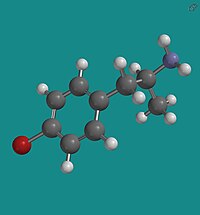para-Bromoamphetamine
This is an old revision of this page, as edited by Seppi333 (talk | contribs) at 01:13, 19 June 2018 (→top: clean up using AWB). The present address (URL) is a permanent link to this revision, which may differ significantly from the current revision.
 | |
 | |
| Clinical data | |
|---|---|
| ATC code |
|
| Identifiers | |
| |
| CAS Number | |
| PubChem CID | |
| ChemSpider |
|
| ChEMBL | |
| CompTox Dashboard (EPA) | |
| Chemical and physical data | |
| Formula | C9H12BrN |
| Molar mass | 214.102 g/mol g·mol−1 |
| 3D model (JSmol) | |
| |
| |
| | |
This article needs additional citations for verification. Please help improve this article by adding citations to reliable sources. Unsourced material may be challenged and removed. Find sources: "Para-Bromoamphetamine" – news · newspapers · books · scholar · JSTOR (November 2009) (Learn how and when to remove this message) |
para-Bromoamphetamine (PBA), also known as 4-bromoamphetamine (4-BA), is an amphetamine derivative which acts as a serotonin-norepinephrine-dopamine releasing agent (SNDRA) and produces stimulant effects.
Neurotoxicity
Like most other para-substituted amphetamines, PBA can be neurotoxic and may deplete the brain of 5-hydroxyindoles for at least a week.[1]
See also
- Substituted amphetamines
- 4-Bromomethcathinone (4-BMC)
- 4-Fluoroamphetamine (4-FA)
- para-Chloroamphetamine (PCA)
- para-Iodoamphetamine (PIA)
References
- ^ Fuller, R. W.; Baker, J. C.; Perry, K. W.; Molloy, B. B. (1975). "Comparison of 4-chloro-, 4-bromo- and 4-fluoroamphetamine in rats: Drug levels in brain and effects on brain serotonin metabolism". Neuropharmacology. 14 (10): 739–746. doi:10.1016/0028-3908(75)90099-4. PMID 1196472.
| Phenethylamines |
|
|---|---|
| Amphetamines |
|
| Phentermines |
|
| Cathinones |
|
| Phenylisobutylamines | |
| Phenylalkylpyrrolidines | |
| Catecholamines (and close relatives) |
|
| Miscellaneous |
|
This drug article relating to the nervous system is a stub. You can help Wikipedia by expanding it. |
This neurotoxin article is a stub. You can help Wikipedia by expanding it. |
- Articles with changed CASNo identifier
- Chem-molar-mass both hardcoded and calculated
- Infobox-drug molecular-weight unexpected-character
- Infobox drug articles with non-default infobox title
- Chemical pages without DrugBank identifier
- Articles without KEGG source
- Articles without UNII source
- Drugs with no legal status
- Drugboxes which contain changes to verified fields
- Drugboxes which contain changes to watched fields
- Articles needing additional references from November 2009
- All articles needing additional references
- All stub articles
